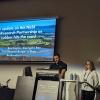When Cyclone Gabrielle blew through Aotearoa in February 2023, it unleashed unprecedented rainfall, triggered widespread flooding and landslip events, and caused significant damage to homes and inf... Read more

Jana Makar
Over the last eight months, a growing coalition has been gleaning new insights about the data in Aotearoa New Zealand's research sector. Working with Research Data Culture Conversation (RDCC) colle... Read more
If you’re a PhD student in high-performance computing, AI, data science, and/or quantum computing fields, a new opportunity has been announced to showcase your dissertation work to an international... Read more
From 16-20 October, members of the NeSI team attended the 2023 eResearch Australasia Conference to learn from peer experiences across the Australian sector as well as share insights from our collab... Read more
Please join us in welcoming the newest members to the NeSI team! Attribution: Lai Kei Peng, Senior Data and Insights AnalystI have been a University of Auckland librarian for more than 10 years a... Read more
A global consortium of scientists from federal laboratories, research institutes, academia, and industry has formed to address the challenges of building large-scale artificial intelligence (AI) sy... Read more
SupercomputingAsia 2024’s (SCA 2024) call for abstracts is now open. Typically held in Singapore, SCA 2024 is coming to Sydney, Australia from 19-22 February 2024. This is is the first time SCA is ... Read more









